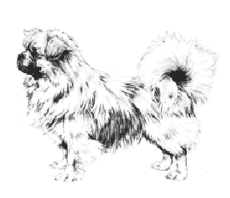Tibetan Spaniel
General Information - Tibetan Spaniel

Group:
Non
Sporting
Size:
Small
Lifespan:
12-15 years
Exercise:
Low
Grooming:
Medium
Trainability:
Medium
Watchdog Ability:
Very high
Protection Ability:
Very low
Area of Origin:
Tibet
Date of Origin:
Ancient times
Other Names:
None
Original Function:
Watchdog, companion
History
The lineage of the Tibetan Spaniel is an ancient one, and no one can be certain how the breed developed. It is assumed that the breed represents a combination of the Pekingese, the Pug and the Japanese Spaniel. Originally bred in Tibetan monasteries, the breed was thought to bring luck and also served the monks by turning the prayer wheel. The breed was well recognsed in both China and Tibet by the 15th century, but it wasn't until 1920 that the first Tibetan Spaniels were imported to England. By the close of WWII, the breed was popular in Britain as a family pet.
Temperament
Small and intelligent, Tibetan Spaniels are not lap dogs. They enjoy sitting atop high objects and surveying their surroundings. The Tibetan spaniel is perky sweet and willful and makes a good watchdog, barking at intruders or anything unusual.
Upkeep
The Tibetan Spaniel’s exercise needs are minimal, but daily. Its needs can be met by games inside the house or yard, or with a short walk on leash. This breed is suited for apartment life and should not live outside. Its coat needs brushing and combing twice weekly.
Tibetan Spaniel
A breed standard is the guideline which describes the ideal characteristics, temperament, and appearance of a breed and ensures that the breed is fit for function with soundness essential. Breeders and judges should at all times be careful to avoid obvious conditions and exaggerations, as well as being mindful of features which could be detrimental in any way to the health, welfare or soundness of this breed.
Breed Standard - Tibetan Spaniel
 Characteristics
Characteristics: Gay and assertive, highly intelligent, aloof with strangers.
General Appearance: Should be small, active and alert. The outline should give a well balanced appearance, slightly longer in body than height at withers.
Head and Skull: Small in proportion to body and proudly carried giving an impression of quality. Masculine in dogs but free from coarseness. Skull slightly domed, moderate width and length. Stop slight, but defined. Medium length of muzzle, blunt with cushioning, free from wrinkle. The chin should show some depth and width. Nose black preferred.
Eyes: Dark brown in colour, oval in shape, bright and expressive, of medium size set fairly well apart but forward looking giving an ape-like expression. Eye rims black.
Ears: Medium size, pendant, well feathered in the adult and set fairly high. They may have a slight lift from the skull, but should not fly. Large heavy low set ears are not typical.
Mouth: Ideally slightly undershot, the upper incisors fitting neatly inside and touching the lower incisors. Teeth should be evenly placed and the lower jaw wide between the canine tusks. Full dentition desired. A level mouth is permissible providing there is sufficient width and depth of chin to preserve the blunt appearance of muzzle. Teeth must not show when mouth is closed.
Neck: Moderately short, strong and well set on. Covered with a mane or “shawl” of longer hair which is more pronounced in dogs than bitches.
Forequarters: The bones of the forelegs slightly bowed but firm at shoulder. Moderate bone. Shoulder well placed.
Body: Slightly longer from point of shoulder to root of tail than the height at withers, well ribbed with good depth, level back.
Hindquarters: Well made and strong, hocks well let down and straight when viewed from behind. Stifle well developed, showing moderate angulation.
Feet: Harefooted, small and neat with feathering between toes often extending beyond the feet. White markings allowed .
Gait: Quick moving, straight, free, positive.
Tail: Set high, richly plumed and carried in a gay curl over the back when moving. Should not be penalised for dropping tail when standing.
Coat: Double coat, silky in texture, smooth on face and front of legs, of moderate length on body, but lying rather flat. Ears and back of forelegs nicely feathered, tail and buttocks well furnished with longer hair. Should not be overcoated and bitches tend to carry less coat and mane than dogs.
Colour: All colours and mixture of colours allowed.
Weight and Size: 4.1 to 6.8 kg (9:15 lb) being ideal. Height about 25.4 cm (10 in).
Faults: Large full eyes, broad flat muzzle, very domed or flat wide skull, accentuated stop, pointed weak or wrinkled muzzle, overshot mouth, long plain down face without stop, very bowed or loose front, straight stifle, cow hocks, nervousness, cat feet, coarseness of type, mean expression, liver or putty coloured pigmentation, light eyes, protruding tongue.
Note: Male animals should have two apparently normal testicles fully descended into the scrotum.
DNZ No 798
Dogs New Zealand
01 Jan 2002
Any departure from the foregoing points should be considered a fault and the seriousness with which the fault should be regarded should be in exact proportion to its degree and its effect upon the health and welfare of the dog and on the dog’s ability to perform its traditional work.




